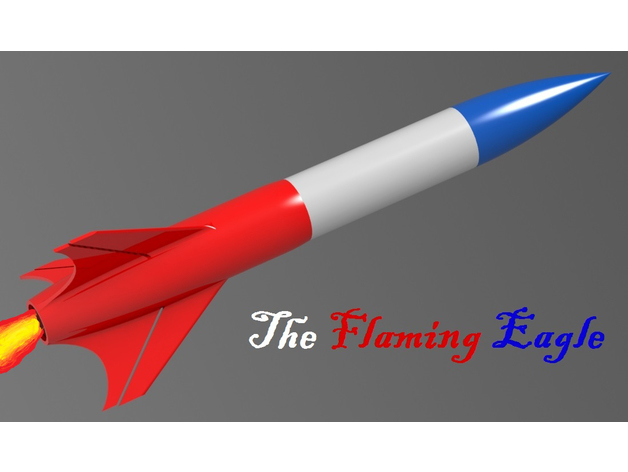
Two-Stage Model Rocket
thingiverse
I designed this using OpenRocket, which is a model rocketry simulator that ran simulations indicating it will reach a height of almost 2,500 feet. The rocket has a stability of 1.00 caliber with both stages and a 1.22 caliber for just the upper stage. So far I've done three test launches with this rocket and the model rocket proved to be very stable on all tests even in some decent wind. We lost sight of the rocket two out of three times, but when we did see it land, we were unable to recover it. If you do plan on actually launching this rocket, you need a clear day and plenty of space. I named my rocket Flaming Eagle and added a really cool flame design to the paint. Assembly Main Rocket For the body tube, you'll need a 33mm diameter cardboard tube. If you're buying it from Estes, it will be a BT-55 sized tube that's 10cm long. The parachute is just a cheap 12in Estes parachute that needs to be attached to a shock cord - any rubber band will work as long as it's strong enough not to break. I also added a ribbon on the shock cord that holds the parachute to assist in deployment. You'll also notice that in the diagram, I added a ribbon connected to the bottom stage of the rocket with its own shock cord, making it easy to find and slowing its descent. To get the highest apogee, you'll need a D12-0 Estes engine for the bottom stage and a D12-7 Estes engine on the upper stage. Launch Lug To make the fall-away launch lug, you'll need a leftover piece of body tube (preferably the same size as the rocket's body tube). It only needs to be about 1-2 inches long. Make a cut down one side of the tube and on the other side create a teeth pattern that's big enough to glue on a straw - there should be one tooth on one side and two on the other (see picture above). Use a cut up rubber band to connect the two pieces on the straight cut edge, then use any leftover rubber band to glue it onto the inside of both pieces for added traction during launches. Next, take a straw and cut it to the same length as the cut up body tube, then cut that piece into three pieces and glue them onto the teeth. Paint is not necessary but recommended for looks - you may also add your rocket's name on the launch lug. Engine setup To get the highest apogee, you'll need a D12-0 Estes engine for the bottom stage and a D12-7 Estes engine on the upper stage. In order to get them to go off correctly, you'll need to add a small amount of scotch tape to hold them together - making sure that the D12-0 is on the bottom and both engines are facing the correct way. You will also have to wrap both engines with masking tape to make sure they fit nice and snug into the rocket. Just be careful not to add too much tape as it can be hard to take out of the rocket afterwards. Before launch, you'll need to add the igniter and wadding just above the D12-7 engine - you may substitute the D12-7 engine with a D12-5 or D12-3 engine but you'll lose some height during flight. Competitions SkillsUSA Wisconsin State Championship In 2016 I entered the model rocketry competition for SkillsUSA in Wisconsin and took third place through my model rocketry skills. In 2017 I entered the contest again, but unfortunately made a miscalculation while assembling the model rocket and it lost control and crashed into the ground - I did not place that year, but I did learn my lesson. Contact Me If you have any ideas on how the design could be improved, questions on anything, or anything else please contact me. You can leave a comment or if you need a quick response send me an email at: borckste000@cudahysd.org.
With this file you will be able to print Two-Stage Model Rocket with your 3D printer. Click on the button and save the file on your computer to work, edit or customize your design. You can also find more 3D designs for printers on Two-Stage Model Rocket.
